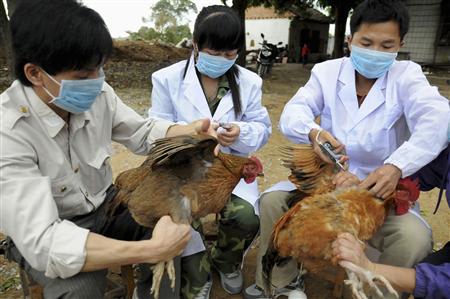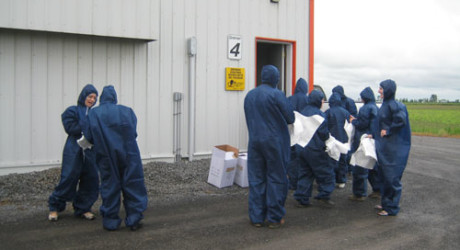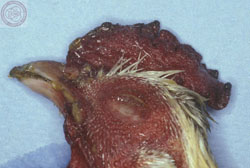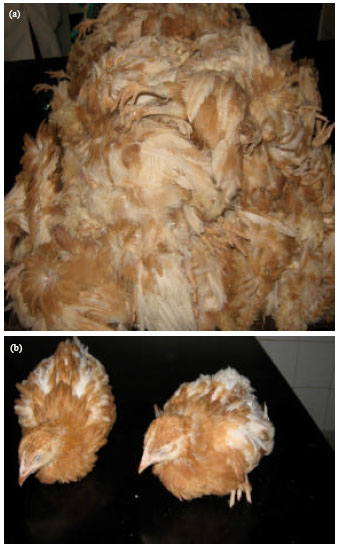 |
| Vaccinating hens against H5N1. (c) Reuters |
Viruses and parasites spread nearly immediately to every bird in the flock. If there are several poultry farms in a small area, the disease can spread from one farm to another in car tires, boots, dirty hands, clothing, by wind etc. "Backyard hens" and wildlife are also a risk to commercial poultry producers. Disease control, preventive medication and quarantines are vital in animal import/export. As the bird influenza -epidemics have shown, international and even global disease outbreaks are possible, and carry heavy consequences to poultry and, in extreme causes, to humans as well.
Each poultry keeper should take and send samples to an official laboratory for disease screening. Easy and quick methods of taking samples are
- Shoe cover sample: Put on dispensable shoe covers, and walk amongst the floor-reared birds. Swap the covers between different sections of the hall. Send the individually-packed dirty covers for screening.
- Feces sample: Mix an adequate amount (100-200g) of feces from all feces collector mats or different parts of the poultry house.
- Incubation sample: Mix 100-200g of broken egg-shells and floor litter from the incubator
- Dust and swab samples: Take and store individual samples from all around the poultry house: floors, corners, feed trays etc.
 |
| (c) The Poultry Guide |
- Allow only necessary guests to the poultry house.
- Ensure all visitors wear disposable shoe covers and other protective clothing provided by the farm.
- Ensure no one enters the poultry house if they've been abroad during the last 48 hours.
- Follow the official and recommended vaccination and medication programmes.
- Monitor the animals and production levels closely.
- Repel indects, flies, rats and other vermin. Ensure wild birds cannot enter the poultry house or feed storage through air ducts or ventilation shafts.
- Use barriers. Make sure all clothing and equipment used in the poultry house is kept there, and all "dirty" clothes and tools are left in the barrier area.
- Follow the all-in, all-out method with thorough cleaning and disinfection between flocks.
Common diseases
 Salmonellosis
SalmonellosisSeveral bacterial strains can cause salmonellosis. Salmonella Enteritidis and S. Typhimurium can infect poultry and humans alike. Both bacteria are infectious if swallowed, and are common in eggshells and feces. Infection through infected feed is rare but possible. S. galliarum infects poultry only, and may cause 100% morbidity in birds of any age. It survives months in a normal climate, but is susceptible to disinfectants. S. pullorum infects only poultry aged three weeks or older.
Symptoms of all types of salmonellosis on poultry are ruffled feathers, closed eyes, diarrhea, loss of appetite and thirst and stunted growth. Post-mortem lesions can occur. Morbidity is low to medium. Salmonella can be cured with antibiotics, which are added to the feed or drinking water. The meat of infected birds may be accepted for normal food processing after heat processing.
Infectious bronchitis, IB
Poultry can and should be vaccinated against IB. IB is caused by a Coronavirus, which evolves rapidly but infects only chickens. The symptoms depend on the age of the chicken. Chicks get flu-like symptoms. Their oviducts are damaged, preventing them from laying eggs later on. Young chickens show only mild symptoms. Adults have respiratory problems, their productivity decreases and their eggs have faulty shells. Some Corona-strains cause damage to kidneys. IB infection lasts 2-8 weeks. Post-mortem lesions can occur. Morbidity is 0-25 %.
IB can be treated with sodium salicylate. Antibiotics are often needed to treat secondary infections by E. coli.
 |
| Skin hemorrhage (c) CFSPH |
ND is caused by some strains of paramyxovirus. In the EU, ND-infections must be confirmed in a reference laboratory in England. The viruses are extremely resistant: it can live months in feces, weeks in carcasses and years in a freezer. ND infects all birds. If an ND-infection is confirmed, a stamp-out may be ordered and all poultry within 3 kilometers must immediately be destroyed.
The symptoms of ND vary, but common ones are decrease of production, moulting, hemorrhage of the comb, skin and eyelids, respiratory problems, paralysis and sudden deaths. There is no cure for Newcastle Disease.
 |
| Typical posture for a hen with MD. (c) Poultry Club SA |
Marek is caused by a herpesvirus. It is transmitted as aerosols via respiration, and may infect all animals in a flock in a short time. The virus proliferates in the roots of the feathers, and is extremely resistant. Many healthy birds carry and spread the virus. Marek infects mostly hens, but the symptoms and susceptibility to infection depend on many factors. Most infected are aged 4 weeks or older, most commonly 9-24 weeks of age.
Symptoms include staggering walk, paralysis, dangling wings, enlarged crop, bent neck, respiratory problems, eye deformations and weight loss. Sick birds have normal appetite. There is no cure for MD, and even cured birds will get infected again later.
 |
| (c) The Poultry Site |
Coccidiosis is caused by one-celled parasites of the Eimeria-family. There are nine known contagious Eimeria-species. The infection happens when chickens eat the eggs of the parasite, often brough to the poultry house in contaminated equipment or cargo boxes. The eggs proliferate in the chicken gut, and 4-7 days after the infection there are Eimeria-eggs in the chicken's droppings. The eggs need 1-3 days outside the chicken's body to become contagious. Eimeria infects mostly chickens of 3-6 weeks.
Symptoms are increased mortality, stunted growth, decreased immunity, diarrhea, bloody feces, dehydration and decrease in egg-laying. Coccidiosis can be prevented by adding coccidiostates to the feed, and by keeping the litter clean and dry. The only treatment is keeping the litter clean and treating the secondary infections with antibiotics.
 |
| (c) Cornell University |
AE is a viral disease of the central nervous system, affecting chickens, pheasants, turkeys, and quail. Grandparent, parent and production line birds can be vaccinated against AE. Developing fetuses can get infected by the parent, but oral infections may also occur. Mortality is high.
Symptoms of AE include sitting, paralysis, tremors, imbalance, muscle weakness and dull apprearance. There are no visible lesions in live animals. There is no treatment for AE.
 |
| (c) Science Alert |
IBDV attacks the immune system of chickens 14-28 days old, causing severe effects in young birds. It is caused by Birnavirus, and infects chickens, turkeys and ducks. White leghorns are more susceptible to Gumboro than brown breeds. The disease is highly contagious, with mortality of 0-20 %. Gumboro increases susceptibility to all other viral and bacterial diseases, including Newcastle Disease.
Symptoms of IBDV are depression, lack of appetite, diarrhea, hiding and unsteady gate. There is no treatment, but vitamins and water may help. Antibiotic medication may be indicated if secondary bacterial infection occurs. All laying chickens and parents to meat chickens must be vaccinated against Gumboro.
 |
| CAV virus (c) ICTV |
CAV and BWD are different names for the same viral disease caused by Gyrovirus. Mortality is 5-10 %. The virus is very resistant to disinfectants, but is destroyed in 5 minutes in 80 C.
Symptoms of BWD/CAV include poor growth, paleness and a sudden rise in mortality. There is no cure for the disease. Good hygiene and management, and control of other diseases as appropriate, may be beneficial. All parent chickens should be vaccinated 6 weeks before their eggs are collected for incubation.
Evaluation of foot health
Leg deformations, broken bones and infections in the soles of the feet are common welfare problems for fast growing birds all over the world. The birds are bred to grow faster than their bones develop, and to a larger size than their feet can carry. Feet health can be improved by- Enough dry and clean litter
- Allowing roosting
- Optimizing the ratio of calcium and phosphorus in the feed
- Optimizing the amount of minerals in the feed
- Keeping low animal density
- Allowing locomotion
- Using slow growing breeds
Post-mortem examinations are done in slaughterhouses by evaluating the quality of foot soles. This can be done on live animals as well, but may cause unnecessary stress. Same visual evaluations can be done on hocks. Chemical and physical measurements such as tensile strength can also be done post-mortem. The dry matter content and ash composition can be measured from bones. Phosphorus and calcium concentrations in bones can be measured after cremation in a spectrofotometer.
 |
| Visual evaluation on foot health. (c) Welfare Quality |
No comments:
Post a Comment